|
Events convened on Friday,
10 December 2004
|
|
New National Communications:
Presentations by Brazil and China
Presented by the Governments of Brazil
and China
|
|
|
|
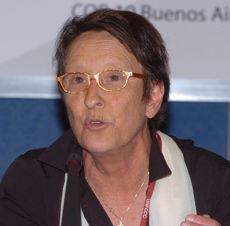 |
|
Joke Waller-Hunter, UNFCCC Executive
Secretary, underscored Brazil’s
leadership regarding biofuels and the
fact that Brazil hosts the first
registered CDM project, and emphasized
that China has succeeded in reducing its
energy intensity by an annual average of
5.3% between 1980 and 2000 |
|
Everton Vargas, Brazilian Ministry
of Foreign Affairs, opened the
ceremony and said that Brazil
officially approved its Initial
National Communication on 8 December
2004, stressing the importance
Brazil attaches to climate change.
He emphasized that the first
registered CDM project is located in
Brazil.
Amb. Gao Feng, Chinese Ministry of
Foreign Affairs, said the joint
event on National Communications is
a sign of positive collaboration
between the two countries, noting
the potential for mutual learning
within various fields. He said the
National Communication together with
the entry into force of the Kyoto
Protocol will help mainstream the
topic of climate change in his
country.
Joke Waller-Hunter, UNFCCC Executive
Secretary, noted that COP-10
celebrates the 10th anniversary of
the UNFCCC and the forthcoming entry
into force of the Kyoto Protocol, as
well as the National Communications
of Brazil and China. She
congratulated the two countries for
having reached this landmark, noting
that National Communications reflect
a broad national policy process. She
underscored Brazil’s leadership
regarding biofuels and the fact that
Brazil hosts the first registered
CDM project, and emphasized that
China has succeeded in reducing its
energy
|
|
intensity by an
annual average of
5.3% between 1980
and 2000. Hunter
expressed her hope
that the two
countries will
continue being
leaders in the
UNFCCC process.
José Miguez,
Ministry of Science
and Technology of
Brazil, presented
highlights of the
Brazilian Initial
National
Communication, which
involved 700 experts
from 150
institutions and was
initiated in 1994.
He said carbon
dioxide emissions
were estimated at
1093 terra grams in
1994, mainly from
the Land-Use and
Forestry sector,
which accounted for
75% of the
emissions, followed
by the energy sector
with 23%.
Paulo Capobianco,
Brazil’s Ministry of
the Environment,
reviewed the
measures adopted by
Brazil regarding
deforestation,
noting that Brazil
has observed an
average
deforestation rate
of 16.5% since 1990.
He said an
inter-ministerial
working group was
set up in 2003 to
launch a plan of
action to prevent
and control
deforestation in the
Brazilian Amazon.
Gao Guangsheng,
Chinese State
Development Planning
Commission, said the
Chinese Initial
National
Communication
followed UNFCCC
Guidelines and is
the result of a
three-year process
that involved over
400 experts.
Ma Aimin, Chinese
Office to National
Climate Change
Coordination
Committee, presented
the Chinese Initial
National
Communication,
noting that the GHG
inventory for 1994
comprises 2.6
billion tons of
carbon dioxide,
34.29 million tons
of methane, and 0.85
million tons of
nitrogen oxide. He
said possible
impacts of climate
change include
shrinking mountain
glaciers, increased
agricultural
production costs,
and the submersion
of areas in South
China due to a rise
in sea levels. Aimin
emphasized that,
while the national
communication
process is time
consuming and
resource demanding,
it results in high
quality data, and
noted that capacity
building is an
important part of
the process.
|
|
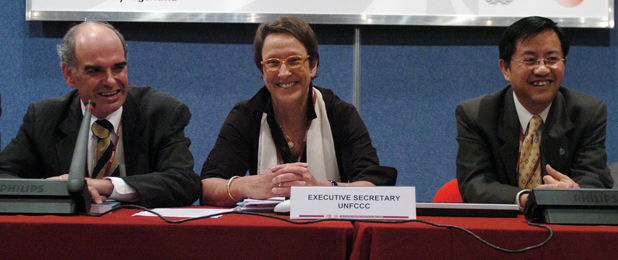 |
|
Everton Vargas, Brazilian Ministry of
Foreign Affairs and Amb. Gao Feng,
Chinese Ministry of Foreign Affairs,
handed over the Initial National
Communication of their countries to Joke
Waller-Hunter, UNFCCC Executive
Secretary |
|
|
|
Disaster reduction and climate change –
opportunities for synergy
Presented by the International Strategy
for Disaster Reduction (ISDR)
|
|
|
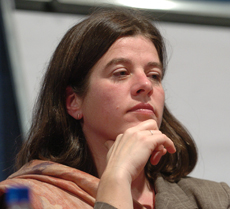 |
|
Madeleen Helmer, Red Cross/Red Crescent
Climate Centre, stressed that climate
risk reduction provides a basis for
cooperation between humanitarian and
environmental actors and that climate
risk reduction strategies should be
embedded in ongoing programmes |
|
Amb. Michael Zammit
Cutajar, Malta,
stressed the need to
invest in increasing
communities’
resilience to
natural disasters.
Noting that poverty
is the ultimate
vulnerability, he
underscored the
importance of
adopting poverty
reduction
strategies.
Madeleen Helmer, Red
Cross/Red Crescent
Climate Centre, gave
an overview of
activities aiming at
integrating climate
risks in
community-based
disaster reduction.
She stressed the
need to both
understand hazards
and address
vulnerability and
risk, noting that
disaster management
is not only about
relief activities,
but also
preparedness and
mitigation. Helmer
said successful
management is based
on local skills and
resources, and
briefly outlined the
Red Cross/Red
Crescent’s efforts
in Nicaragua and
Viet Nam.
Ian Noble, World
Bank, presented the
activities of the
Vulnerability
Adaptation Resource
Group (VARG), an
informal group of 18
bilateral and
multilateral
agencies. He
outlined the main
conclusions of its
report “Poverty and
Climate Change,”
including the need
to integrate climate
change responses
with hazard
reduction management
and operate within |
|
the development
agenda. He reviewed
similarities and
differences between
hazard risk
management and
adaptation to
climate change,
noting that a lack
of understanding of
the benefits of
integration, funding
and institutional
silos represent
obstacles to linking
these issues.
Svein Tveitdal, UNEP,
said at least 200
million people are
affected by natural
disasters annually,
97% of whom live in
developing
countries. He gave
an overview of
UNEP’s activities
aimed at increasing
synergies between
disaster reduction
and climate change,
including gathering
of statistics and a
financial initiative
with Munich Re.
Stressing that an
investment of US$1
in preparedness
would save US$6 in
the costs of
recovery and
reconstruction
following disasters,
he underscored the
importance of
focusing on adaptive
capacity and
prevention.
John Harding, ISDR,
reviewed recent
priorities for
disaster risk
reduction, which
will be addressed at
the World Conference
on Disaster
Reduction in Kobe,
Japan, from 18-22
January 2005. He
said the Kobe
Conference aims to,
inter alia: conclude
the review of the
implementation of
the Yokohama
Strategy and Plan of
Action; facilitate
implementation of
the objectives of
the World Summit on
Sustainable
Development and the
Millennium
Development Goals;
and share
information on good
practices,
shortcomings and
obstacles. He
briefly outlined the
Conference’s
thematic areas
including
governance,
education and
awareness raising,
preparedness and
risk identification,
assessment,
monitoring and early
warning.
|
|
|
Climate witnesses challenge decision
makers in industrial countries
Presented by the World Wildlife Fund (WWF)
|
|
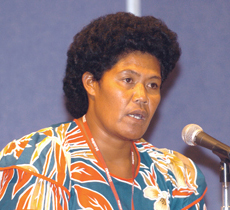 |
|
Penina Moce, Fiji, said drought induced
by climate change had caused soil
erosion, pest invasions and crop
disruption in her village in Fiji |
|
Jennifer Morgan, WWF, announced the
launch of the WWF Climate Witness
Programme, which seeks to raise
awareness of climate change impacts.
She said WWF benefits from input
from scientists, establishes
partnerships with other
organizations, and engages
communities through surveys,
interviews and public education.
Morgan then invited four witnesses
to tell their stories in order to
assist politicians in recognizing
the urgent need for action.
Osvaldo Bonino, Argentina, showed a
video recounting the impacts of
climate change in the Santa Fe
province of Argentina, where
increased rainfall raised the water
levels in a lagoon, flooding
agricultural fields and railways,
and causing widespread socioeconomic
disruption.
Penina Moce, Fiji, reviewed the
problems encountered by her village
community in Fiji. Noting that her
village depends exclusively on
rainfall for water supply, she said
the dry season has extended in
recent years |
|
and her island has suffered
from rapid soil erosion,
drought, pest infestation,
crop destruction and coral
bleaching.
Anil Krishna Misry, India,
discussed the impacts of
climate change on his island
in West Bengal. Noting that
summers are getting longer
and drier, he said many
villagers have lost their
land due to rising sea
levels and droughts. A short
film further illustrated
local problems, including
socioeconomic difficulties,
disruption of mangrove
ecosystems and loss of
species caused by increased
freshwater salinity
resulting from sea level
rise.
Norbu Sherpa, Nepal,
recounted his personal
experience with climate
change impacts. He said
glaciers in the Himalaya
Mountains are melting
rapidly, and noted that a
glacial lake had burst and
flooded his village, causing
his family to lose
everything they owned. He
called on the international
community to take action,
and said climate change
policy is about people and
their livelihoods.
|
|
Designing future international actions
on climate change
Presented by the Center for Clean Air
Policy (CCAP)
|
|
 |
|
Ned Helme, CCAP, indicated that senior
negotiators from 30 countries are
involved in CCAP’s work on options for
the post-2012 policy framework |
|
Ned Helme, CCAP, discussed sectoral
options for a post-2012 climate
policy framework. Comparing a
sectoral approach to the current
country-based approach under the
Kyoto Protocol, he said targeting
individual sectors would be easier,
allow countries to gain experience
incrementally, and avoid transfers
of industrial activities from
developed to developing countries.
Regarding disadvantages, he noted
that a sectoral approach would be
less cost effective, and warned
against the possibility of
“emissions leakage” outside covered
sectors.
Jake Schmidt, CCAP, discussed five
possible designs for a sectoral
system based on: emissions growth
cap; target of emissions per unit of
industrial output; sector
benchmarks; sector policy credit
generation; and cross-national
policy harmonization. He said key
questions include: which sectors
should be included; whether rules
should be binding; how reduction
targets should be set; and how a
sectoral approach should
|
relate to the CDM.
In a panel discussion, Fernando
Tudela, Mexico’s Ministry of
Environment and Natural Resources,
said the policy framework of the
Kyoto Protocol is not replicable in
the developing world, and that
sector differentiation is
indispensable for any program for
future action, noting that, in some
sectors, certain developing
countries are more energy efficient
than some developed countries.
Jürgen Lefevere, European
Commission, highlighted the
challenges of preventing emissions
leakage outside sectors, addressing
cross-sectoral compatibility, and
integrating the sectoral approach
with the country-based approach. He
said concerns with global
competitiveness are greater
obstacles than policy costs.
Discussion: Participants said a
sectoral approach may be applied
within particular regions, and
suggested that lessons may be drawn
from sectoral approaches in the
shipping and aviation industries. It
was noted that commitments must be
binding on business, and that
industrial associations must be
liable in national courts. Lefevere
said incentives for participation
are essential for implementation,
noting that climate policies provide
business opportunities. Highlighting
a lack of information and awareness
among companies regarding policies,
Lefevere also said governments have
a major role in stimulating market
mechanisms and can capitalize on
business concerns about global
competitiveness. One participant
said the emergence of a sectoral
approach on the policy horizon could
create uncertainty and undermine
current policies on CDM.
|
|
CDM in Latin America: A way already
paved for investments
Presented by the Government of Peru
|
|
 |
|
Christiana Figueres, CAF, emphasized the
stability of the Latin American market
for CDM investment |
|
Maria Teresa Szaur, Andean
Corporation of Promotion (CAF),
indicated that the Latin American
region has seen a growth and
strengthening of both the CDM market
and the capacity to engage in CDM
projects, with the creation of a
robust regional institutional
framework.
Christiana Figueres, CAF, noted that
Latin America has demonstrated
political leadership in the climate
regime, with nearly all Latin
American countries having ratified
the UNFCCC and the Kyoto Protocol.
She said Latin America is a leader
in CDM projects, and outlined a
number of reasons. First, she
highlighted the robust CDM project
portfolio in Latin America, in terms
of quantity, quality and diversity.
She also emphasized the expertise in
developing and implementing CDM
projects, and highlighted
involvement of the private sector.
Indicating that strong institutional
backing for CDM mitigates risk, she
stressed that the comprehensive
coverage of Designated National
Authorities (DNAs), local |
|
verification and certification
services, and the activities of the
regional development bank all reduce
transaction costs for CDM projects
in Latin America. Figueres
highlighted the contribution of the
CDM to sustainable development in
Latin America, identifying social
and economic benefits, and stressed
that Latin America has the capacity
to participate in a climate regime
beyond 2012.
Discussion: Participants considered
how to resolve potential conflicts
of interest between the public and
private sectors, and stressed the
importance of engaging all sectors
and including CDM in national
development strategies. A
participant highlighted the major
contribution of transport to GHG
emissions, and questioned why the
transport sector has been overlooked
when developing CDM projects.
Another participant enquired as to
whether hydrofluorocarbon projects
could be anticipated in Latin
America, and representatives from
Latin American DNAs indicated that
none were expected. Figueres said
funding for DNAs came from public
sources, revenues from fees for
project evaluation and international
cooperation. A participant suggested
that the experience vested in Latin
American DNAs could be communicated
to funding institutions in order to
build their capacity to engage in
CDM project development. The need to
ensure the quality of project
proposals in order to attract
investors was stressed. |
|
Climate friendly technologies: Roles of
the government, business and the finance
sector
Presented by the International Center
for Environmental Technology Transfer (ICETT)
|
|
 |
|
Margaret Martin, EGTT, highlighted the
importance of risk management and
mobilizing private capital for
technology transfer. |
|
Toshi Sakamoto, Climate Technology
Initiative (CTI), introduced the CTI,
indicating that it is a multilateral
initiative aimed at facilitating the
transfer of climate technologies.
Elmer Holt, CTI, stressed the
importance of partnerships, private
sector engagement, enabling
environments and targeted capacity
building in promoting technology
transfer.
Margaret Martin, Chair of the Expert
Group on Technology Transfer (EGTT),
reported on the EGGT workshop on
innovative financing options for
technology transfer held in
Montreal, Canada, from 27-29
September 2004. She stressed the
facilitating role of partnerships
and the need for enabling
environments.
Terry Carrington, CTI, reported on a
workshop on technology diffusion
held in Jakarta, Indonesia, on 4-5
February 2004, indicating that the |
|
workshop had examined the current
energy situation, renewable energy,
possibilities for regional
cooperation, governance, financial
barriers and the CDM.
Morihiro Kurushima, CTI, stressed
that CTI works with government and
financial institutions to provide a
“tool box for energy and the
environment.”
Kishan Kumarsingh, EGTT, highlighted
the need to develop enabling
environments in developed countries
to facilitate technology transfer,
such as providing financial
incentives.
Larisa Dobriansky, US Department of
Energy, noted that mobilizing
private sector investment for
technology transfer requires clear,
transparent and predictable
regulations.
Andrej Kranjc, Slovenia’s Ministry
of Environment and Spatial Planning,
identified three pillars for
technology transfer, namely
financing, an enabling environment
and the coordinating role of
governments.
Nick Campbell, International Chamber
of Commerce, stressed that
technology transfer is ”alive and
well” in the private sector,
emphasizing that private companies
are always seeking new markets.
Patricia Garffer, US Agency for
International Development,
introduced the US Climate Technology
Cooperation Gateway website, which
provides climate technology
information in an accessible format
for business and other stakeholders.
Discussion: Participants considered
whether the EGTT should provide
information on the adaptation of
technologies for small island
developing States. They role of
business in diffusing climate
technology to support the goals of
the UNFCCC, stressing the importance
of certainty. |
|
Legal aspects of carbon in the
implementation of CDM afforestation,
reforestation projects
Presented by the World Conservation
Union (IUCN)
|
|
 |
|
Juan Rodrigo Walsh, Fundacion Vida
Silvester Argentina/WWF, indicated that
the market is awaiting clarification of
rules on CDM sink projects before taking
action. |
|
Heiner von Luepke, Food and
Agricultural Organization of the
United Nations, presented a study on
national regulations concerning CDM
projects in the forestry sector. He
said there is pressure to find
national legal frameworks before the
first Kyoto commitment period
starts, and outlined regulatory
options including market mechanisms,
subsidies, command and control
legislation and information systems.
Maria Socorro Manguiat, IUCN,
identified additionality, the right
to Certified Emission Reductions (CERs)
and environmental and socioeconomic
standards as the most pressing legal
challenges to national regulation
regarding CDM sink projects. She
said legal reform may not be the
best solution to address these
issues in the short term.
Juan Rodrigo Walsh, Fundacion Vida
Silvester Argentina/WWF, outlined
the legal and institutional
framework for CDM in Argentina. He
said environmental laws make public
consultations a mandatory part of
the CDM approval process, and noted
that the fiduciary mechanism, a
specific property right in
Argentina’s Civil Code, could be
useful for CDM |
|
sink projects. He emphasized that
economic and political stability are
more important for CDM projects than
legal reform, and said improved
coordination between federal and
provincial authorities is needed. He
said the additionality of CDM sink
projects is difficult to demonstrate
in Chile because the forestry sector
is well established.
Discussion: Participants discussed
ways of sharing benefits from CDM
sink projects with local
communities. They said while there
is no single rule, options include
straight payments, CERs, trust
funds, specific investment into the
community, and splitting the
proceeds between investors and
landowners. Manguiat noted that
projects with clear synergies with
the Convention on Biological
Diversity and the UN Convention to
Combat Desertification might not be
eligible under the CDM because of
additionality criteria. Participants
noted that the additionality
requirement may also discourage
countries from setting new
environmental standards, but
recognized that “the additionality
tool” by the CDM Executive Board has
addressed some of these problems.
Participants suggested that the
current definition of forests may be
problematic for the additionality of
CDM sink projects in countries with
tropical forests. Walsh said while
countries can decide to nationalize
the right to carbon, it is unclear
whether this policy yields benefits. |
Mainstreaming mitigation and adaptation
into German development cooperation –
examples from the GTZ
Presented by the Government of Germany
|
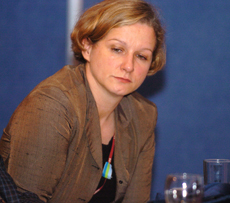 |
|
Kerstin Dietrich, GTZ, referred to the
publication “South-North Dialogue on
Equity in the Greenhouse,” a proposal to
develop an adequate and equitable global
climate agreement. |
|
Kerstin Dietrich, Gesellschaft für
Technische Zusammenarbeit (GTZ),
outlined the climate protection
policy of Germany, noting that it is
based on the principle of decoupling
of economic growth and GHG
emissions, through improving energy
efficiency and renewable energy
systems.
R.K. Sethi, Indian Ministry of
Environment and Forests, overviewed
CDM activities in India,
underscoring auspicious factors for
CDM projects in his country,
including a strong economy and
business community, skilled CDM
consultants, and a well-established
legal system. Noting that the CDM
approval process is normally
completed within 60 days, he said 37
Indian projects had received host
country approval to date.
Pamposh Bhat, CDM-India, presented
the Indo-German Bilateral Programme
to institutionalize CDM by building
capacity of public and private
actors to foster high quality CDM
projects. She emphasized that CDM-India
aims to work in full cooperation
with the Indian DNA |
|
|
and cooperates with large Indian
companies developing CDM projects.
Elisabeth Mausolf, GTZ, explained
GTZ’s adaptation policy, which is
based on a holistic approach that
tries to mainstream adaptation to
climate change into the activities
of the German Development
Cooperation. She said priority
sectors include water resources,
agriculture, terrestrial ecosystems,
coastal zones, human settlements and
health. Mausolf outlined GTZ’s
country initiative in Mali,
emphasizing, inter alia, the
importance of a multi-stakeholder
approach, communication among
stakeholders, improvement of the
agro-meteorological service, and
measures against soil erosion.
Robert Dilger, GTZ, spoke on climate
change in Nicaragua and the GTZ
Sustainable Resource Management
Program, which will build on
existing projects and comprises
policy assessment, land use planning
and development of entrepreneurial
skills.
Liana Bratasida, Indonesia’s
Ministry of Environment, said her
country ratified the Kyoto Protocol
in October 2004, and the DNA is
about to be formalized. |
|
|
|







